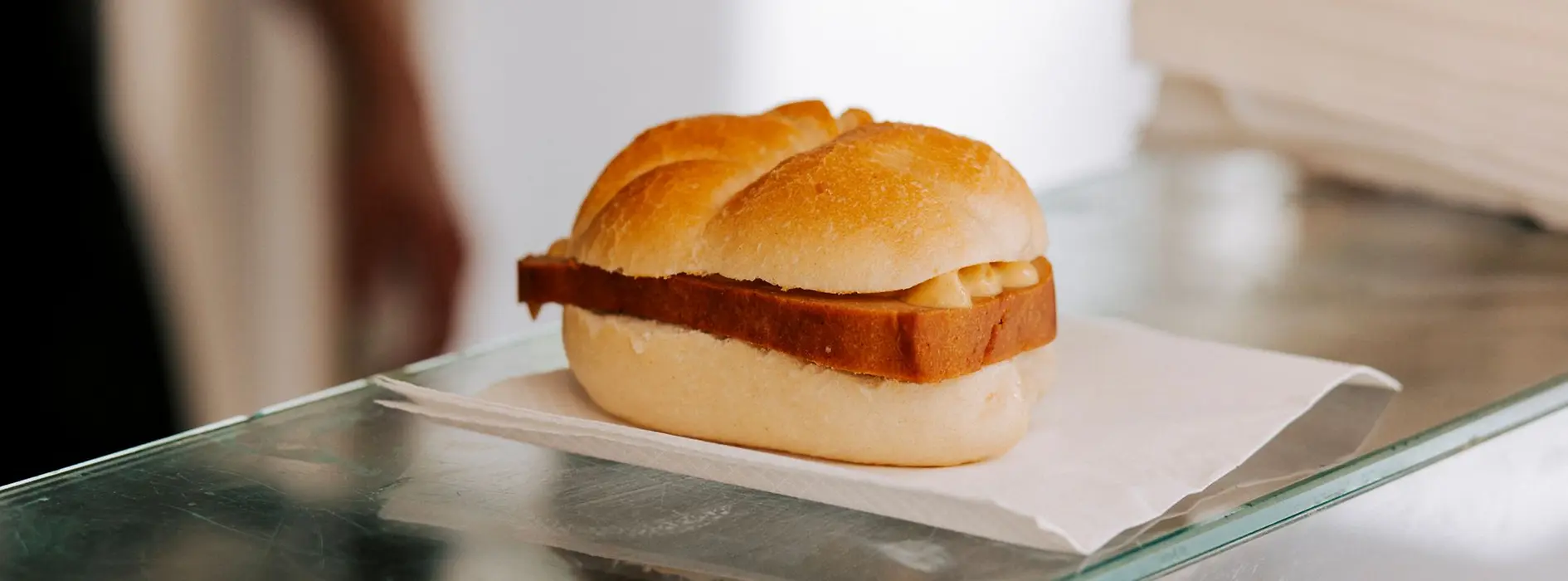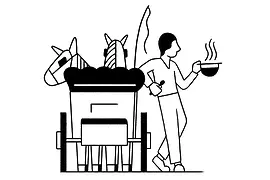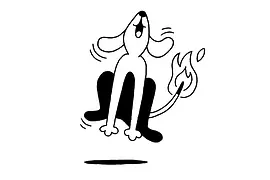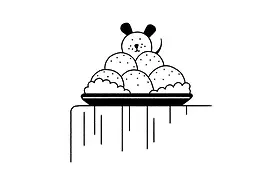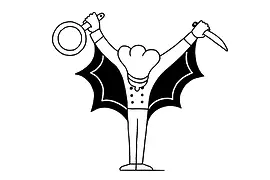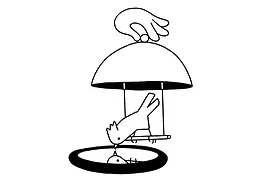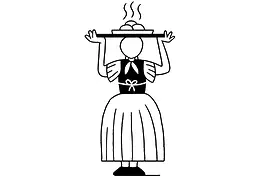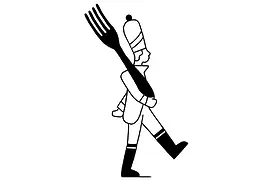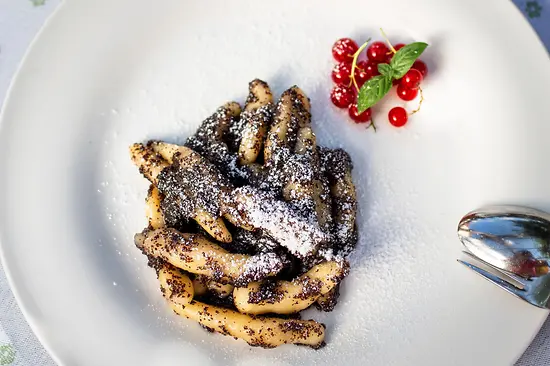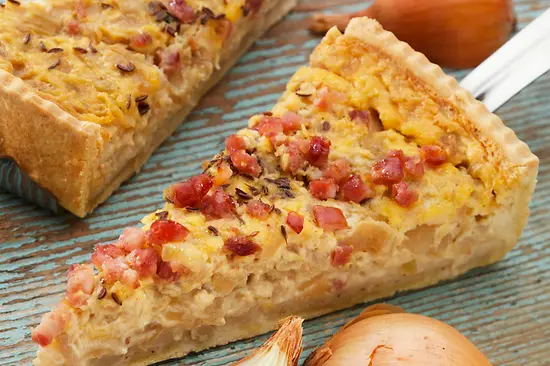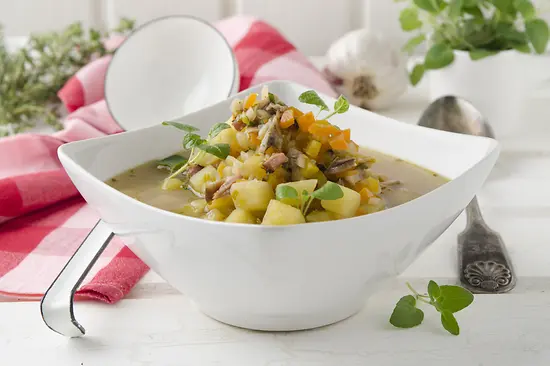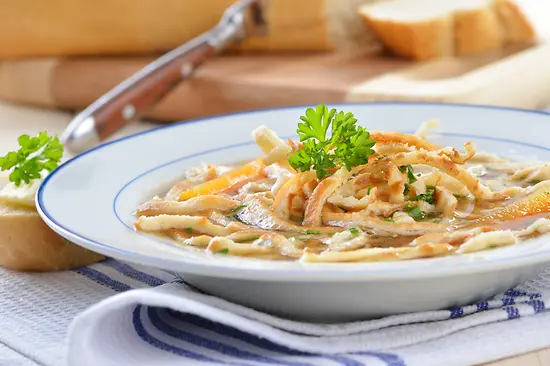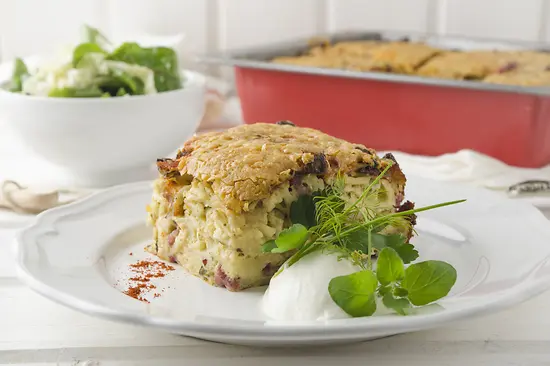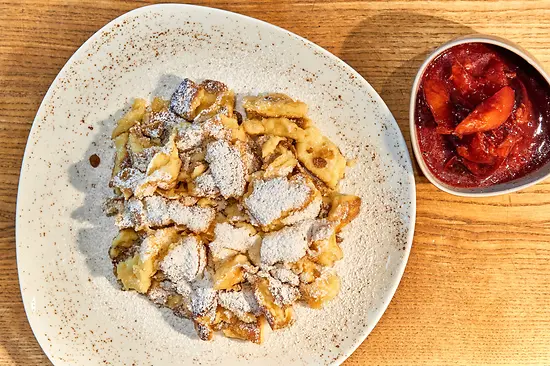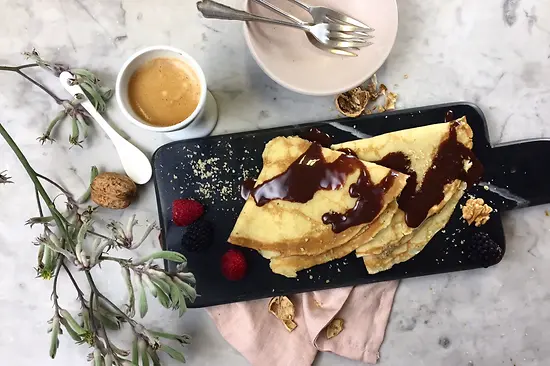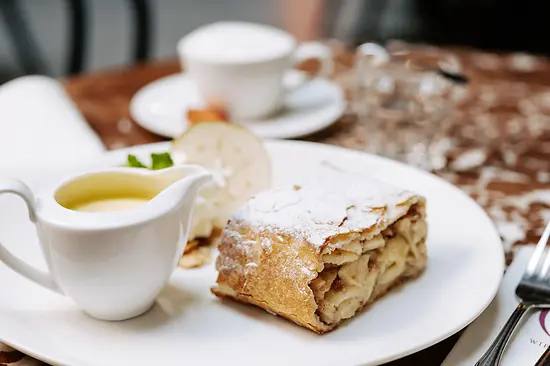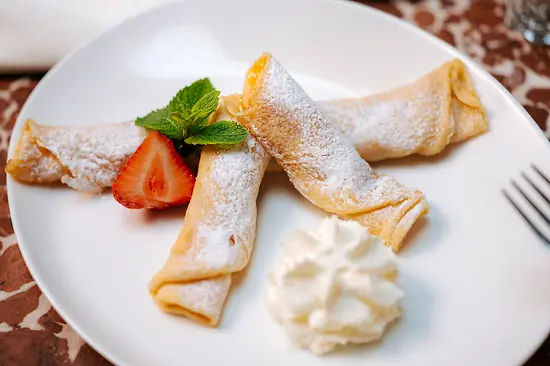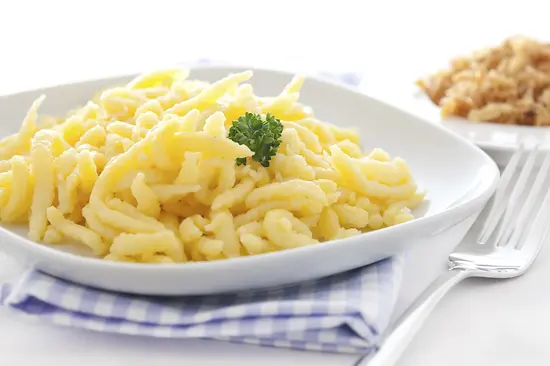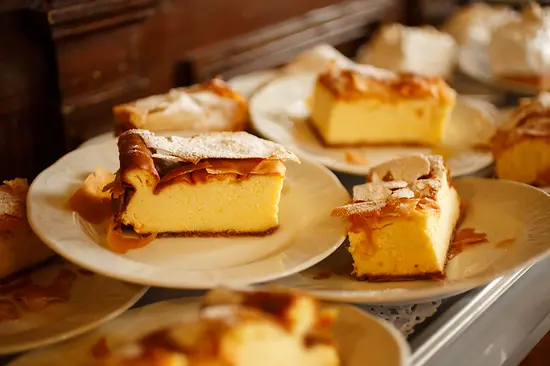Quirks of Viennese Cuisine
Einspänner (“one-horse carriage”)
An Einspänner is actually a cart or carriage drawn by a single horse. And this is where the name of this Viennese coffee specialty comes from. The carriage drivers, sitting on their boxes, wanted the coffee in their hand to stay warm as long as possible. And hey presto: their mokka (a double espresso) was covered with a large topping of whipped cream – which acts as a kind of insulation, keeping the coffee warm for a good while. Today the Einspänner is also served to non-carriage drivers in Vienna’s coffeehouses, in a stylish glass mug with a handle. Although Einspänner has a second meaning: it is also the name for a single Frankfurter or Sacherwürstel. But that’s another story...
Fiakergulasch (“carriage driver goulash”)
Well, yes, horses are one of those things in Vienna. Horse meatloaf (see Leberkäse below) is viewed as a particularly tasty delicacy here. But don’t worry, no one eats the horses that pull carriages, or makes goulash out of them. Fiakergulasch is a classic beef goulash. It is served with an Einspänner – a single Frankfurter sausage – as well as a bread dumpling and a fanned pickled cucumber, all topped with a fried egg. This hearty meal was once the ideal fuel for horse-drawn carriage drivers.
Einbrennte Hund (“singed dogs”)
Don’t worry – no one eats dogs in Vienna. Viennese “Einbrennte Hund” is actually a potato dish. This is a classic from the old days, which due to its simple ingredients was often seen as paupers’ fare, or food to eat while fasting during Lent. The name was inspired by the way it is prepared: first, a roux (Einbrenn) is made using fat (ideally lard) and flour – called a “flour sweat” – preferably with onion and spices. Beef broth is added, then boiled or leftover potatoes – et voila. These days Einbrennte Hund is served as a side dish with an Augsburger sausage, or with bacon and pickles.
Überstürzter Neumann (“topsy-turvy Newman”)
This coffee specialty was named for a certain Herr Neumann (Mr. Newman), a regular patron of the legendary Café Herrenhof, who liked to enjoy his coffee in a highly specific way. You can read about the Einspänner coffee above. And this Einspänner is the inspiration here: Herr Neumann wanted to drink his Einspänner upside-down. So, to make an Überstürzter Neumann, first the whipped cream is placed in the coffee cup, then the double espresso is poured over it when the coffee is served, at the guest’s table. So what is different, compared to an Einspänner? In the original creation, the espresso coffee stays black; while in an Überstürzter Neumann, the coffee slowly mixes with the cream. It’s the finer details that matter, as Herr Neumann knew all too well. Whether Herr Neumann ever felt topsy-turvy while drinking his coffee has not been passed down to posterity.
Frankfurter Würstel im Schlafrock (“Frankfurter sausage in a nightgown”)
Frankfurter sausages are only really found in Vienna. In the vast majority of other places, this homegrown classic is known as a “Wiener”, or Viennese sausage. In 1805 Johann Georg Lahner, a butcher and meat curer from Frankfurt, wrote Viennese history when he first produced this sausage calling it “Frankfurter”, in honor of his home town. Served with mustard and horseradish, it quickly became a popular mid-morning snack among the Viennese. Lahner also developed another way to serve his Frankfurter sausages: baked in a covering of shortcrust or puff pastry, they are called Würstel im Schlafrock.
Gebackene Mäuse (“deep-fried mice”)
One of the sweetest childhood memories! We all loved deep-fried mice as children. This classic Viennese dessert is made from balls of yeast dough, which are reminiscent of little mice once they have been deep-fried. It is served warm with vanilla custard, but can also be eaten cold.
Vanillerostbraten (“braised beef with vanilla”)
This dish certainly sounds interesting: a braised beef escalope, flavored with vanilla? You’ve just got to give it a try! But you could be in for a big surprise when the dish is served, and it turns out to be beef in a garlic sauce. Why, then, is it called Vanillerostbraten? Again, the reason is historical: in former times, garlic was known as “the poor man’s vanilla.” Vanilla was expensive, and only the rich could afford this luxury spice. And – braised beef with vanilla sounds a lot better than braised beef with garlic.
Fledermaus (“bat”)
What now – they eat bats in Vienna? Not quite. The Fledermaus is in fact a special cut of beef or pork. It is cut from the sacrum, between the hip bones, and in shape resembles a bat. This rare, special cut of beef is ideally boiled and served in the same way as another Viennese classic, Tafelspitz; a pork Fledermaus is usually breadcrumbed and fried. The butcher’s craft was formerly a high art requiring a great deal of dexterity. The Viennese method of butchering beef was particularly highly regarded, producing a greater variety of cuts than anywhere else in the world. The individual cuts had distinctive names like Kavalierspitz (cavalier cut) – or, of course, Fledermaus.
Kanarienmilch (“canary milk”)
This ancient recipe for vanilla sauce would surely even tempt a canary. Or is it called canary milk because the egg yolks give the custard a distinctive yellow sheen, reminiscent of a canary? This Austrian version of custard is in any case somewhat thinner, and is served with desserts such as Buchteln, gebackene Mäuse (see above), Milchrahmstrudel, Topfenpalatschinken and apple strudel. And in Vienna the sauce is sometimes called Kanarimilch.
Leberkäse (“liver cheese”)
If you visit a grocery store in Vienna at lunchtime, at the delicatessen counter you’ll experience a continuous line of people ordering a Leberkäs’-Semmel – a slice of Leberkäse in a bread roll. You would be forgiven for believing that Leberkäse is the main source of nutrition for the Viennese. Indeed, the Leberkäs’-Semmel is one of the Austria’s most popular snacks, and the country’s fast food par excellence. But do the Viennese really love to eat cheese stuffed with liver? Of course not – Leberkäse actually has nothing to do with liver, but literally means: oddments in a tin. And that actually describes it perfectly. To make Leberkäse, finely chopped pork – sometimes with a little beef – is mixed with a range of spices and baked in a loaf pan. And in the case of Käse-Leberkäse, it really does have cheese in it. With mustard and horseradish, pickles or ketchup, the Leberkäs’-Semmel is a fine delicacy that’s also popular at sausage stands.
Wiener Schlosserbuben (“Viennese locksmith lads”)
The world of Viennese cakes, pastries and desserts is filled with recipes that have evocative names. This old Viennese dessert is one of them. To make Wiener Schlosserbuben, depending on the recipe prunes are soaked in apple juice and plum schnapps, or boiled in red wine laced with cloves. They are then stuffed either with an almond or with marzipan, covered in batter and fried in hot oil until they are golden brown. Before serving, they are garnished with a mixture of sugar and grated chocolate – and in a final flourish, sometimes accompanied by vanilla custard. And why the name? Supposedly because of the darkcolored filling that resembles the apprentice fitters’ grimy faces.
Wiener Wäschermädel (“Viennese laundry girls”)
The culinary counterpart to Schlosserbuben are the Wiener Wäschermädel. In 19th-century Vienna, laundry girls were known to be funloving, light-hearted, and cheeky. Numerous balls were held in their honor. And Wäschermädel are also especially sweet as a dessert. Stoned apricots are filled with marzipan, then dipped in batter and, just like Schlosserbuben, fried in hot oil until golden brown. They are often accompanied by an apricot sauce.
Grenadiermarsch (“grenadier march”)
For a change, this dish isn’t named after an animal. Grenadiermarsch originated in the military, where meals needed to be prepared quickly and economically. It was invented during the imperial era, and today remains a classic dish for using up leftovers. Potatoes and pasta are cooked up with bacon and left-over sausage, and flavored with onion, marjoram, parsley, and sometimes garlic. Restored by this hearty meal, a grenadier would be able to march on at full strength.
Kalbsvögerl (“veal birds”)
What is this exactly? An unusual species of bird? Or a special cut of veal? That’s right – Kalbsvögerl is the name for fillets of veal cut from the hind leg. They are the same size as a small bird (hence the name), and there are many different recipes for them. Poached, larded with bacon, braised, served with a cream sauce – whatever recipe is used to prepare them, Kalbsvögerl are always especially tender and full of flavor.
Scheiterhaufen (“pyre”)
Don’t worry, no one is going to be burned at the stake! And certainly not this delicious creation. In Austria, sweet dishes are often served as a main course. On meatfree days lunch could be a soup followed by a sweet dish – such as Scheiterhaufen. The way the ingredients are layered – like when building a bonfire – gave the dish its name. Sliced stale bread rolls, plaited loaves or croissants are soaked in a mixture of eggs and milk, and then layered alternately with thinly sliced apples in a baking dish. The apples are prepared in advance with raisins, sugar and cinnamon. The milk and egg mixture is poured over, then the dish goes straight into the oven. Some chefs also like to fold beaten egg whites into the bread mix, and create a meringue topping. This gives the dish a fine, airy lightness. Scheiterhaufen is another typical dish for using up leftovers.
Text: Susanne Kapeller
